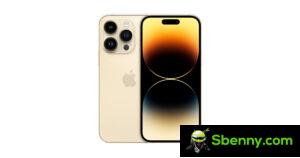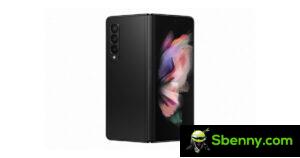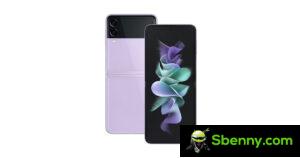We subjected the Samsung Galaxy Z Fold5 to our rigorous SBMARK Battery test suite to measure its performance in terms of battery life, charging and efficiency. In the results of these tests, we will analyze how it performed in a number of tests and in several common use cases.
Overview
Key Specifications:
- Battery Capacity: 4400mAh
- 25W charger (not included)
- 7.6-inch OLED display, 1812 x 2176, 120Hz
- Qualcomm Snapdragon 8 Gen 2 (4nm)
- ROM/RAM combination tested: 256GB + 12GB
Pros
- Decent battery life for a foldable phone if used moderately
- Good battery life when streaming videos (device open)
- Low residual consumption of the wired charger
- Low discharge currents for video streaming, gaming and scrolling on social apps
Against
- Low battery life when listening to music
- Poor battery life when using the camera (device open)
- Long wireless charging time: 2 hours 49 minutes
- Low wireless charging efficiency
- High residual consumption of the wireless support
The Samsung Galaxy Z Fold5’s battery performance scored the best to date among the foldable devices we’ve tested so far, although its score was just below average in our global ranking. The Z Fold5 showed improvements in battery performance over its predecessor Z Fold4, across all subscores, especially in terms of runtime and efficiency.
With moderate use, the battery of the Samsung Galaxy Z Fold5 lasted about 2 days and 6 hours, which is just below average but better than other foldable devices. The Z Fold5 showed good performance during the explained use case tests. The discharge currents were low, and the battery life was good when streaming video and decent when gaming, but also when scrolling through social apps (tested folded). Therefore, the device has been well optimized for such screen-on use cases. The battery life was poor and the discharge currents were high when streaming music, making calls and using the camera.
The low-power 25W charger slowed the pace of charging, taking 1 hour and 44 minutes to reach full charge, while a 5-minute charge provided just 3 hours and 43 minutes of runtime. Wireless charging also took longer than average, taking 2 hours and 49 minutes to fully charge the battery. Additionally, the residual power consumption from the wireless stand was among the highest we’ve seen, but the residual power consumption from the wired charger was excellent whether the fully charged device was still plugged in or not. Therefore, the efficiency was average for wired charging but weak for wireless charging.
Compared to other Ultra-Premium devices, the battery life and efficiency of the Samsung Galaxy Z Fold5 were above average, which is very good for a foldable phone. However, the charging experience was poor for this segment.
Trial summary
Learn about SBMARK battery tests: For scoring and analysis in our smartphone battery reviews, SBMARK engineers conduct a series of objective tests over a one-week period both indoors and outdoors. (See our introduction and how we test articles for more details on our smartphone’s battery protocol.)
The following section compiles the key elements of our extensive testing and analysis performed in the SBMARK laboratories. Detailed performance evaluations in the form of reports are available upon request. Do not hesitate to contact us.
| Drums | Battery charger | wireless | Screen | Processor | |
|---|---|---|---|---|---|
| Samsung Galaxy Z Fold5 | 4400mAh | 25W (not included) |
15W | AMOLED 1812 x 2176 |
Qualcomm Snapdragon 8 Gen 2 |
| Samsung Galaxy Z Fold4 | 4400mAh | 25W (not included) |
15W | AMOLED 1812 x 2176 |
Qualcomm Snapdragon 8+ Gen 1 |
| Honor to magic vs | 5000mAh | 66W (included) |
– | OLEDs 1984 x 2272 |
Qualcomm Snapdragon 8+ gen1 |
Autonomy
113
Samsung Galaxy Z Fold5 battery
188
Honor X7a
Honor X7a
How the autonomy score is composed
The Battery Life Score is made up of three performance subscores: Home/Office, On the Go, and Calibrated Use Cases. Each subscore includes the results of a full range of tests to measure range in all kinds of real-life scenarios.
75 hours
Light use
Active: 2h30/day
54 hours
Moderate use
Active: 4 hours a day
34 hours
Intensive use
Active: 7 hours a day
Home office
115
Samsung Galaxy Z Fold5 battery
213
Honor X7a
Honor X7a
A robot housed in a Faraday cage performs a series of touch-based user actions during what we call our “typical usage scenario” (TUS) (making calls, streaming video, etc.) – 4 hours of active use over the course of 16 hours. – a period of one hour, plus 8 hours of “sleep”. The robot repeats this series of actions every day until the device runs out.
In movement
117
Samsung Galaxy Z Fold5 battery
195
Samsung Galaxy M51
Samsung Galaxy M51
The use of the smartphone on the go puts a strain on autonomy due to additional “hidden” needs, such as the continuous signaling associated with the selection of the cellular network. SBMARK Battery experts take the phone outdoors and perform a series of well-defined activities following the same three-hour travel itinerary (walking, taking the bus, the subway…) for each device
Calibrated
107
Samsung Galaxy Z Fold5 battery
198
Samsung Galaxy M51
Samsung Galaxy M51
For this series of tests, the smartphone returns to the Faraday cage and to our bots repeatedly perform actions related to a specific use case (like gaming, video streaming, etc.) at a time. Starting with an 80% charge, all devices are tested until they have used at least 5% battery power.
In charge
114
Samsung Galaxy Z Fold5 battery
218
Realme GT Neo 5 (240W)
Realme GT Neo 5 (240W)
How the recharge score is composed
Charging is a full part of the overall battery experience. In some situations where range is at its lowest, knowing how fast you can charge becomes a concern. The SBMARK Battery Recharge Score is made up of two subscores, (1) Full Charge and (2) Quick Boost.
Charge complete
109
Samsung Galaxy Z Fold5 battery
224
Realme GT Neo 5 (240W)
Realme GT Neo 5 (240W)
The full charge tests evaluate the reliability of the battery charge indicator; measure how much time and how much energy it takes for the battery to charge from zero to 80% capacity, from 80 to 100% as shown by the user interface, and until fully charged.
The charging curves, in wired and wireless mode (if available) show the evolution of the battery level indicator as well as the energy consumption in watts during the charging phases towards full capacity.
The charging curves, in wired and wireless mode (if available) show the evolution of the battery level indicator as well as the energy consumption in watts during the charging phases towards full capacity.
Quick push
119
Samsung Galaxy Z Fold5 battery
212
Realme GT Neo 5 (240W)
Realme GT Neo 5 (240W)
With the phone at different charge levels (20%, 40%, 60%, 80%), the quick boost tests measure how much charge the battery receives after being plugged in for 5 minutes. The graph here compares the average range gain with a 5-minute quick charge.
Efficiency
118
Samsung Galaxy Z Fold5 battery
154
Oppo Reno6 5G
Oppo Reno6 5G
How the efficiency score is composed
The SBMARK Energy Efficiency Score is composed of two sub-scores, Charge Rate and Discharge Rate, both of which combine data obtained during a typical robot-based usage scenario, calibrated testing and charge rating, taking into consideration battery capacity of the device. SBMARK calculates the product’s annual energy consumption, shown in the graph below, which is representative of overall efficiency during a charge and when in use.
Charge Up
128
Samsung Galaxy Z Fold5 battery
205
Nubia Red Magic 7 Pro
Nubia Red Magic 7 Pro
The secondary charge score is a combination of four factors: the overall efficiency of a full charge, related to the amount of energy required to fill the battery compared to the energy the battery can supply; the efficiency of the travel adapter when it comes to transferring power from an outlet to your phone; the remaining consumption when the phone is fully charged and still connected to the charger; and the residual consumption of the charger itself, when the smartphone is disconnected from it. The graph below shows the overall efficiency of a full charge in %.
Discharge
113
Samsung Galaxy Z Fold battery5
194
Apple iPhone 14 Pro
Apple iPhone 14 Pro
The sub-discharge score evaluates how quickly a battery discharges during a test, which is independent of battery capacity. It is the ratio of the capacity of a battery divided by its autonomy. A small capacity battery may have the same run time as a large capacity battery, indicating that the device is well optimized, with a low discharge rate.







Start a new Thread